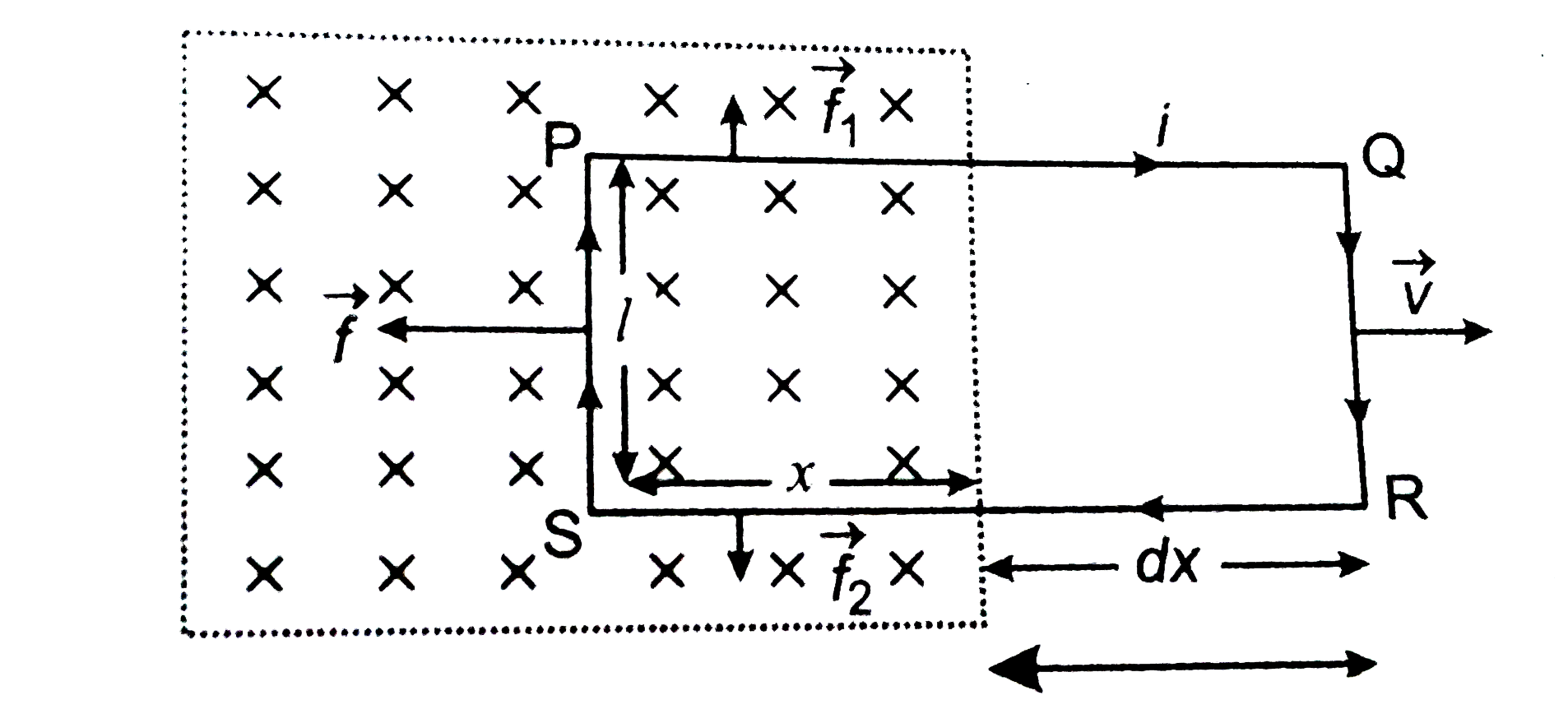Prove theoretically the relation between e.m.f. induced in a coil and rate of change of magnetic flux in electromagnetic induction. A parallel plate air condenser has a capacity of 20 μF. What will be the new capacity if:
(a) the distance between the two plates is doubled ?
(b) A marble slab of dielectric constant 8 is introduced between the two plates ?
Consider a rectangular loop of conducting wire PQRS partly placed in uniform magnetic field of induction 'B' which is perpendicular to the plane of paper and directed into the paper.

Let l be the length of the side PS and x be the length of the loop within hte field.
Therefore, A=lx, area of that loop which lies inside the field.
The magnetic flux (ϕ) through the area A at certain time 't' is ϕ=BA=Blx.
The loop is pulled out of the magnetic field of induction 'B' to the right with a uniform velocity →v.
The rate of change of magnetic flux,
dϕdt=ddt(Blx)
∴dϕdt=Bl(dxdt)
But, v=(dxdt)
∴dϕdt=Blv ...(i)
Due to change in magnetic flux, induced current is set up in the coil. The direction of this current is clockwise according to Lenz's law. Due to this the sides of the coil experiences the forces f1,f2andf.
The magnitude of force f acting on the side PS is
f=Bil (∵→f=i→l×→B)
Since, →f1and→f2 are equal and opposite, so they cancel out.
The unbalanced force which opposes the motion of the coil is f. Hence, the external agent like hand must do work against this force in order to pull the coil.
The work done in time dt during displacement dx is
dW=−fdx
(Negative sign shows that →fand−→dx are opposite to each other)
∴dW=−(Bil)dx ...(ii)
The work done must be equal to the electrical energy generated. If e is the induced e.m.f. and i is the induced current,
Electric work =dWdt=ei
dW=e ...(iii)
Equating equations (ii) and (iii), we get
e=−Bildx
∴e=−Bl(dxdt)
∴e=−Blv
Using equation (i),
e=dϕdt
Numerical :
(a) Given, C=20μF.
We know,
Capacitance, C=Kaε0d
For air, K=1
∴C=Aε0d ...(i)
Then,
New capacitance, C'=Aε0d'
∴d'=2d
=Aε02d
=C2 [From equation (i)]
=202
=10μF
So, if the distance between the plates is doubled capacity of condenser becomes 10μF.
(b) When K = 8
∴C''=K'Aε0d=8Aε0d
=8C [∵Aε0d=C]
=8×20
=160μF [From equation (i)]
If a slab of dielectric constant 8 is introduced between the plates, the capacity becomes 8 times i.e., 160μF.
Topper's Solved these Questions
- FEBRUARY 2018Book:GURUKUL PUBLICATION - MAHARASHTRA PREVIOUS YEAR PAPERSChapter: FEBRUARY 2018Exercise:SECTION-II
Explore 21 Videos
- FEBRUARY 2016Book:GURUKUL PUBLICATION - MAHARASHTRA PREVIOUS YEAR PAPERSChapter: FEBRUARY 2016Exercise:SECTION-II
Explore 21 Videos
- FEBRUARY 2019Book:GURUKUL PUBLICATION - MAHARASHTRA PREVIOUS YEAR PAPERSChapter: FEBRUARY 2019Exercise:SECTION-D
Explore 6 Videos
Similar Questions
A parallel-plate air capacitor has a capacitance of 4μF. What will be its new capacitance if (i) the distance between the plates is redced to half the initial distance (ii) a slab of dielectric constant 5 is introduced filling the entire space between the two plates?
View SolutionA parallel plate capacitor with air between the plates has a capacitance C. If the distance between the plates is doubled and the space between the plates is filled with a dielectric of dielectric constant 6, then the capacitance will become.
View Solution
Knowledge Check
The capacity of a paralel plate condenser is 12μF. What is its new capacity if the separation between the plates is doubled and the area is halved?
A1.5μFB3μFC6μFD8μFA parallel plate condenser is connected with the terminals of a battery. The distance between the plates is 6mm. If a glass plate (dielectric constant K=9) of 4.5mm is introduced between them, then the capacity will become
A2 timesBthe sameC3 timesD4 timesThe distance between the plates of a parallel plate condenser is 8mm and P.D.120 volts. If a 6mm thick slab of dielectric constant 6 is introduced between its plates, then
Athe charge on the condenser will be doubledBthe charge on the condenser will be reduced to halfCthe P.D. across the condenser will be 320 voltsDthe P.D. across the condenser will be 45 volts
A parallel plate capacitor with air between the plates has a capacitance 2μF. The capacity of the condenser when the distance between the plates is reduced to half of initial distance is
View SolutionA parallel plate air capacitor has a capacity of 2 pF. If the separation between its plates is doubled and a mica sheet is introduced between its plates, its capacity becomes 6 pF. What is the dielectric constant of mica?
View SolutionIf the distance between the plates of a parallel plate capacitor of capacity of μF is doubled, then new capacity will be
View SolutionA parallel state air capacitor has capacitance of 100 μF. The plates are at a distance d apart. If a slab of thickness t (t≤d) and dielectric constant 5 is introduced between the parallel plates, then the capacitance can be
View SolutionIf the distance between the plates of parallel plate capacitor is halved and the dielectric constant of dielectric is doubled, then its capacity will
View Solution
